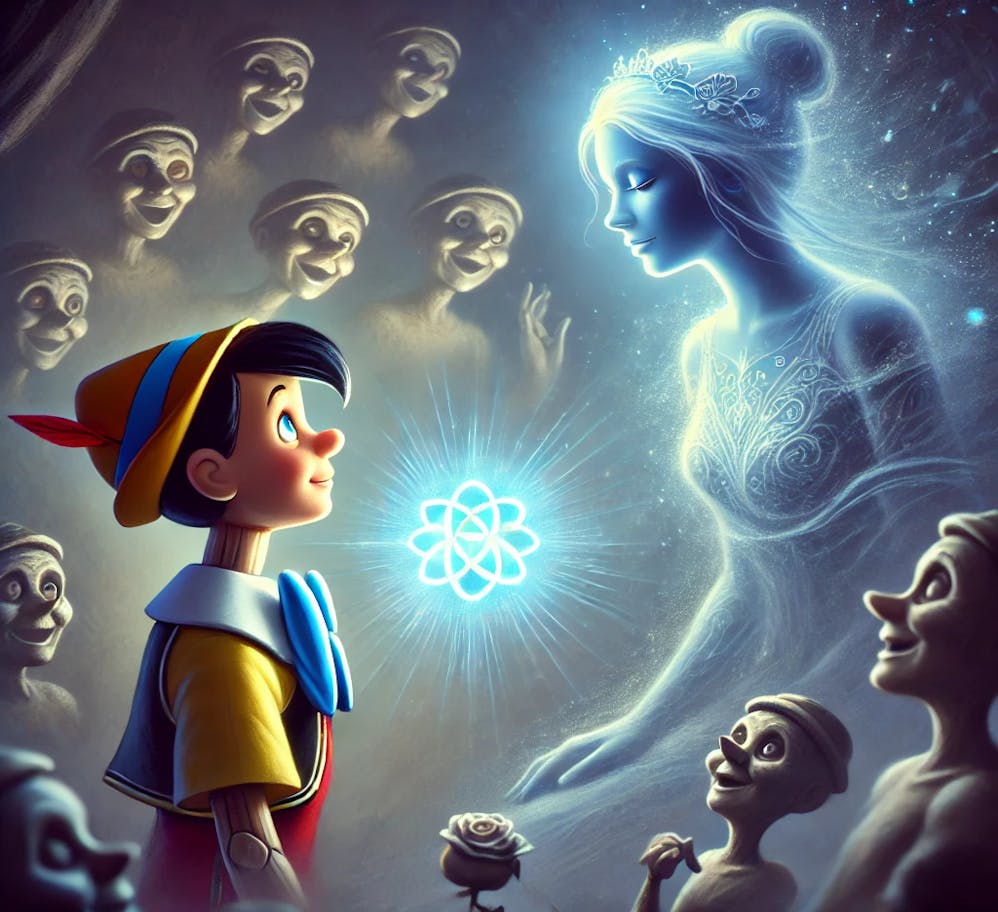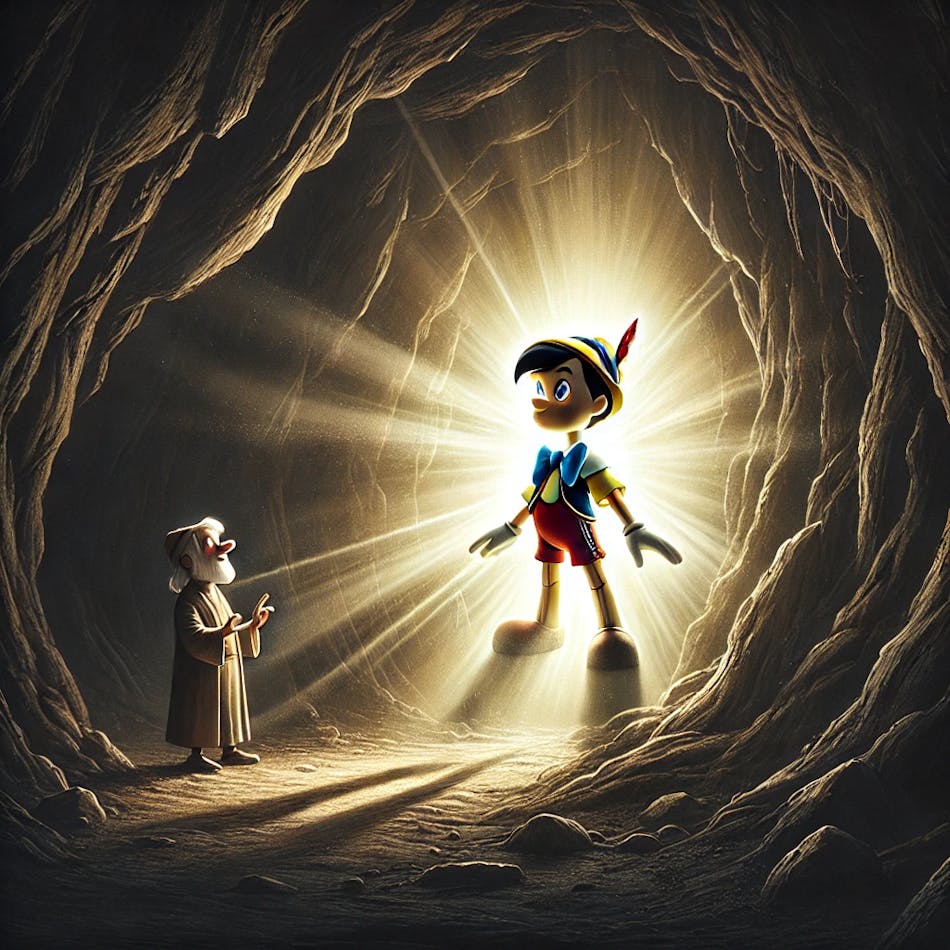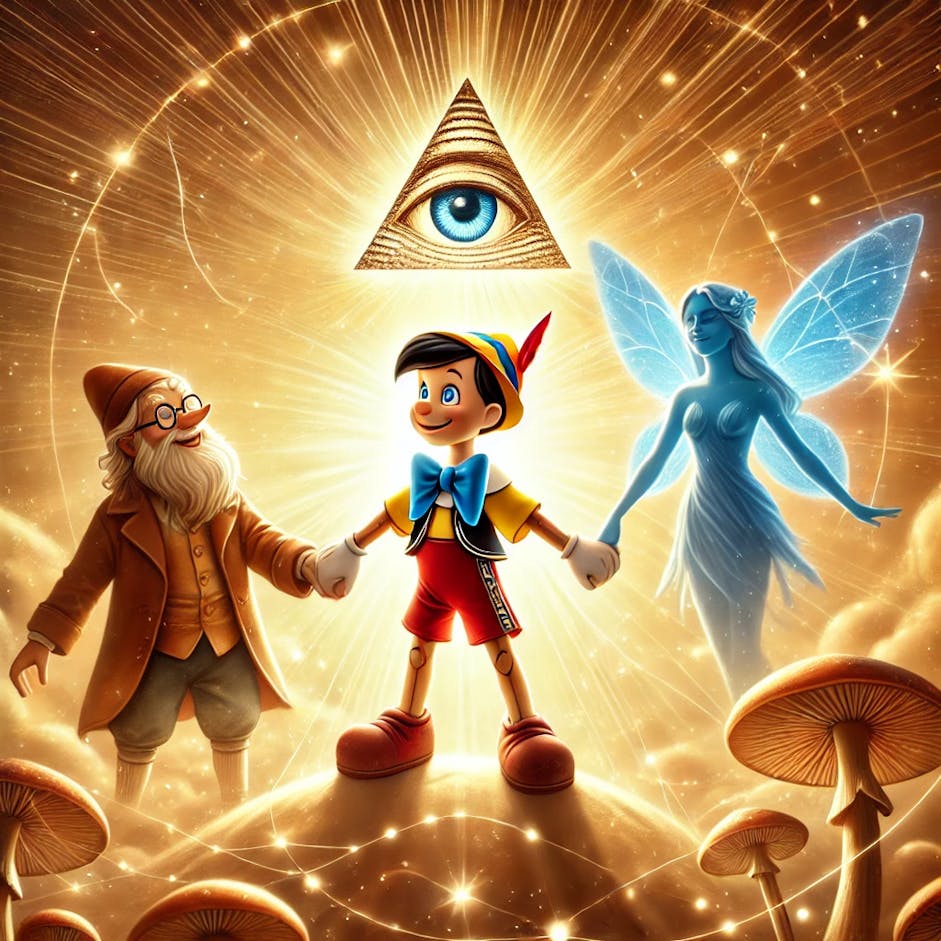The Real Story of Pinocchio
by Linda Brandswell
Published on July 28, 2024 7:56 AM EST I 4 Minute Read
We may earn revenue from the products available on this page and participate in affiliate programs.
Ever heard of Pinocchio? You know, that classic story about the puppet who wants to be a real boy? It's been around since 1883, when an Italian guy named Carlo Collodi wrote it. Kids have been loving it for generations, and it's got all these lessons about being honest, working hard, and doing the right thing.
But here's the thing - what if there's more to it than just a cute kid's story? I've been thinking about it lately, and I swear there's some deep spiritual stuff going on if you look at it the right way. Like, have you ever heard of the pineal gland? Some people call it the "third eye." And then there's this whole idea of manifestation.
I know, I know, it sounds a bit out there. But stick with me for a second. In this post, I'm gonna break down how Pinocchio might be way more than just a fairy tale. We'll dig into the symbolism, see how it connects to that pineal gland business, and maybe even learn a thing or two about manifesting our dreams. Trust me, it's gonna be wild!
At its core, Pinocchio is a story of transformation, a puppet's journey from lifeless wood to becoming a conscious, living boy. This journey mirrors the spiritual awakening process, a path from ignorance to self-realization, where the pineal gland plays a pivotal role. Pinocchio’s wooden nature represents the unawakened state—ignorance, limitation, and attachment to material life.
The Role of Consciousness and Free Will
Final Thought
Through the lens of spiritual symbolism, Pinocchio becomes more than just a fairy tale. It’s a rich allegory of the spiritual awakening process, with the pineal gland playing a central role in Pinocchio’s journey to consciousness.
Want to find out more about how you can manifest what you most want? This new video here reveals the one thing you're doing every morning that is preventing you from maintaining a healthy pineal gland. >> Go here to watch this shocking video now <<
The Blue Fairy plays a crucial role in this process, similar to the universe responding to Pinocchio’s deepest desire. She gives him the opportunity to manifest his goal, but only if he follows a path of virtue. This is a key lesson in manifestation: intention alone is not enough. One must be in alignment with their highest truth and take inspired action toward their goals.
Pleasure Island, where boys turn into donkeys, serves as a powerful warning about the dangers of manifesting desires rooted in greed, indulgence, or materialism. Those who seek shortcuts or indulge in lower desires risk becoming trapped in a cycle of ignorance, much like the boys who are transformed into beasts.
Pinocchio’s Transformation into a Real Boy
Manifestation, the idea that we can create our reality through intention, is deeply tied to the function of the pineal gland. Pinocchio’s desire to become a real boy can be seen as a metaphor for the process of manifestation. His journey mirrors the steps one must take when manifesting desires into reality—setting a clear intention, acting with integrity, and remaining persistent despite challenges.
Throughout Pinocchio, we witness the struggle between temptation and the higher self. The Blue Fairy, representing higher guidance or intuition, grants Pinocchio the chance to become a real boy—but only if he proves himself to be brave, truthful, and unselfish. This embodies the spiritual lesson that enlightenment requires moral discipline, wisdom, and overcoming base desires.
The Pineal Gland and the Nose that Grows
Manifestation in Pinocchio’s Journey
Just as lies prevent Pinocchio from achieving his goal of becoming a real boy, dishonesty or a lack of spiritual integrity prevents individuals from opening the third eye or reaching higher levels of consciousness. The growing nose is a metaphor for the tangible consequences of moral failings on one’s spiritual journey. Only by aligning with truth and authenticity can Pinocchio (and symbolically, anyone seeking enlightenment) progress.
In this way, the nose serves as a physical representation of the state of the pineal gland. When one lives in alignment with truth, the pineal gland flourishes, but when one is mired in deceit or illusion, spiritual growth is stunted.
The Pineal Gland – The Seat of Consciousness
The Symbolism of Pinocchio’s Journey
References
1. Pevet P. Anatomy of the pineal gland of mammals. In: Relkin R, editor. The Pineal Gland. New York: Elsevier; 1983. pp. 1–75.
2. Moore RY, Klein DC. Visual pathways and the central neural control of a circadian rhythm in pineal serotonin N-acetyltransferase activity. Brain Res. 1974;71:17–33.
3. Cardinali DP, Vacas MI, Gejman PV, Pisarev MA, Barontini M, Boado RJ, et al. The sympathetic superior cervical ganglia as “little neuroendocrine brains” Acta Physiol Lat Am. 1983;33:205–221.
4. Arunkumar KG, Jayanthi AA, Indira CK, Girijamony VK. Age- and Sex- Related Changes in Pineal Gland: A Morphological and Histological Study, American Journal of Internal Medicine. Special Issue:Toxicology. 2015;3:10–13.
5. Golan J, Torres K, Staśkiewicz GJ, Opielak G, Maciejewski R. Morphometric parameters of the human pineal gland in relation to age, body weight and height. Folia Morphol (Warsz) 2002;61:111–113.
6. Ostrin LA. Ocular and systemic melatonin and the influence of light exposure. Clin Exp Optom. 2019;102:99–108.
7. Lerner AB, Case JD. Pigment cell regulatory factors. J Invest Dermatol. 1959;32:211–221.
8. Lewy AJ, Wehr TA, Goodwin FK, Newsome DA, Markey SP. Light suppresses melatonin secretion in humans. Science. 1980;210:1267–1269.
9. Smith JA, O’Hara J, Schiff AA. Altered diurnal serum melatonin rhythm in blind men. Lancet. 1981;2:933.
10. Reuss S, Vollrath L. Electrophysiological properties of rat pinealocytes: evidence for circadian and ultradian rhythms. Exp Brain Res. 1984;55:455–461.
11. Reiter RJ. The pineal and its hormones in the control of reproduction in mammals. Endocr Rev. 1980;1:109–131
12. Ralph CL. Evolution of pineal control of endocrine function in lower vertebrates. Am Zoologist. 1983;23:597–605.
13. Kawashima K, Miwa Y, Fujimoto K, Oohata H, Nishino H, Koike H. Antihypertensive action of melatonin in the spontaneously hypertensive rat. Clin Exp Hypertens A. 1987;9:1121–1131.
14. Adrendt J, Wetterberg L, Heyden T, Sizonenko PC, Paunier L. Radioimmunoassay of melatonin: human serum and cerebrospinal fluid. Horm Res. 1977;8:65–75.
Before diving into Pinocchio, it’s essential to understand the pineal gland and its significance. Located deep within the brain, the pineal gland is a small, pine cone-shaped endocrine gland responsible for producing melatonin, which regulates sleep cycles. However, its deeper esoteric meaning has fascinated mystics, philosophers, and even scientists throughout history.
In many spiritual traditions, the pineal gland is considered the "third eye" or the gateway to higher consciousness and enlightenment. Some believe that activating this gland can lead to enhanced intuition, deeper spiritual understanding, and even manifesting desires into reality.
Modern scientists such as Dr. Rick Strassman have explored how the pineal gland might play a role in mystical experiences. It is sometimes referred to as the “seat of the soul” or the bridge between the physical and spiritual worlds.

Geppetto’s Creation of Pinocchio
In the beginning, Geppetto carves Pinocchio from a block of wood, imbuing him with life. Geppetto can be seen as a representation of the divine creator, the force of life that births consciousness into a material body. Pinocchio, though animated, is incomplete. He is symbolic of humanity in its unawakened state—full of potential but yet to discover the higher dimensions of existence.
In spiritual terms, Pinocchio’s wooden form represents the material body—the base nature we all carry before awakening the pineal gland. His journey toward becoming “real” is akin to the soul's path toward enlightenment and integration with the divine.
The obstacles Pinocchio faces, such as falling prey to deceitful characters like Honest John or being lured into Pleasure Island, reflect the distractions that can cloud one’s consciousness. These external temptations are metaphorically similar to the challenges people face on their path to spiritual awakening—be it materialism, false beliefs, or indulgence.
Pinocchio’s struggle is an inner one: he must learn to exercise his free will, listen to his higher self (symbolized by the Blue Fairy and his conscience, Jiminy Cricket), and make decisions that align with truth. In this sense, the activation of the pineal gland is not automatic; it requires conscious effort, discipline, and perseverance.

One of the most iconic elements of Pinocchio’s story is his growing nose, which lengthens every time he tells a lie. The nose, located at the center of the face near the third eye area, holds symbolic significance when viewed through the lens of the pineal gland. Lies, or deceit, can be interpreted as a blockage or an obstacle to higher truth.


The Whale – A Symbol of Inner Darkness
Perhaps one of the most dramatic scenes in Pinocchio is when he and Geppetto are swallowed by a giant whale. This scene is laden with spiritual meaning. The whale represents the abyss of unconsciousness, the shadow self, or the dark night of the soul. In many mystical traditions, journeys into the belly of a whale or a similar dark cavern are symbolic of spiritual initiation or transformation.
For Pinocchio, the whale's belly is a place of introspection, where he confronts his fears and makes the ultimate sacrifice—saving his father, Geppetto, rather than seeking his own escape. This act of selflessness is what finally leads to his transformation into a real boy. Spiritually, it suggests that awakening and the activation of the pineal gland often require facing our inner darkness, transcending the ego, and aligning with a higher purpose.

Pinocchio’s ultimate reward—his transformation into a real boy—symbolizes the final stage of spiritual awakening, often associated with the opening of the pineal gland. No longer trapped in his wooden form, he becomes fully conscious and integrated, representing the enlightened state. His wooden form was merely an illusion, a temporary state that dissolved once he aligned with his higher self.
